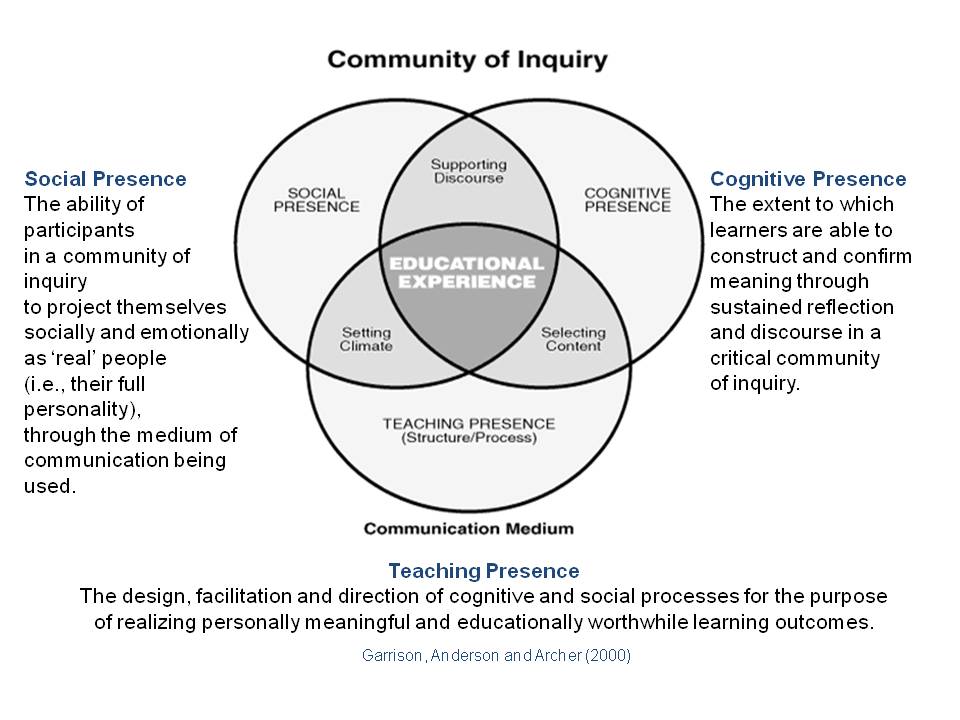Online doesn’t have to mean alienating. The Community of Inquiry framework for teaching and learning online can be a helpful way of conceptualizing how communities of learners can be built and supported online.

The educational experience for online learners is comprised of the instructor’s presence, the social experience of working with colleagues, and their ability to work through the course content.
Community of Inquiry has been a framework in place since 2000, and it stands up to all the technological innovations of the intervening years — be cause like so much of good online teaching, it’s not really about the technology at all. You can dig into this idea more by reflecting on a Concept Map developed by Joop Van Schie, which offers practical applications for all the listed areas.
You develop teaching presence by introducing yourself to learners, being vulnerable and honest where appropriate, responding to learner outreach in a timely fashion, etc. Consider specific interventions like including video/audio greetings, preparing weekly check-ins, and setting and following an email response policy.
You develop social presence by making space for learners to have social conversations (and for frivolity!) with you and with each other, creating opportunities for low-stakes interactions between learners, and facilitating group cohesion. Consider specific interventions like a “café corner” forum, allowing students to respond with audio/video where appropriate, and embracing any inside jokes that emerge over the term.
You develop cognitive presence by giving learners multiple ways to express their understanding, including opportunities of reflection, and maintaining engagement with course materials through term. Consider specific interventions like offering choice in how students do assessments, building in scaffolding for assessments, and portioning marks across all the course components.
At TRU, our instructional designers produced a resource for building the crucial first week of classes, which is where much of this presence is first established.
Synchronous / Asychronous
There are two options for instructors to facilitate class sessions remotely:
- Synchronous: instructors and students gather at the same time and interact in “real time.” Think: zoom lectures.
- Asynchronous: instructors prepare course materials for students in advance of students’ access. Students may access the course materials at a time of their choosing and will interact with each over a longer period of time. Think: flipped classrooms.
One is not necessarily better than the other! When disruptions are regularly expected, asynchronous makes a lot of sense because it is much more flexible. But learners need additional supports to learn how to be asynchronous learners if that is new to them.
Advantages of Synchronous Teaching
- Immediate personal engagement between students and instructors, which may create greater feelings of community and lessen feelings of isolation
- More responsive exchanges between students and instructors, which may prevent miscommunication or misunderstanding
Disadvantages of Synchronous Teaching
- More challenging to schedule shared times for all students and instructors
- Some students may face technical challenges or difficulties if they do not have fast or powerful Wi-Fi networks accessible
Advantages of Asynchronous Teaching
- Higher levels of temporal flexibility, which may simultaneously make the learning experiences more accessible to different students and also make an archive of past materials accessible.
- Increased cognitive engagement since students will have more time to engage with and explore the course material.
Disadvantages of Asynchronous Teaching
- Students may feel less personally exchanged and less satisfied without the social interaction between their peers and instructors.
- Course material may be misunderstood or have the potential to be misconstrued without the real-time interaction.
Discussion and Reflection
Discussion: Do you have any learning experiences with online modalities yourself? What made those experiences positive or negative, and why? Do you feel like that experience offered teaching/social/cognitive presence?
Reflection: We’ll take five minutes together for the following exercise. Think about your next teaching experience. Jot some notes down about how you could develop teaching, social, and cognitive presence in your own classes. Try to identify 2-3 strategies for each.